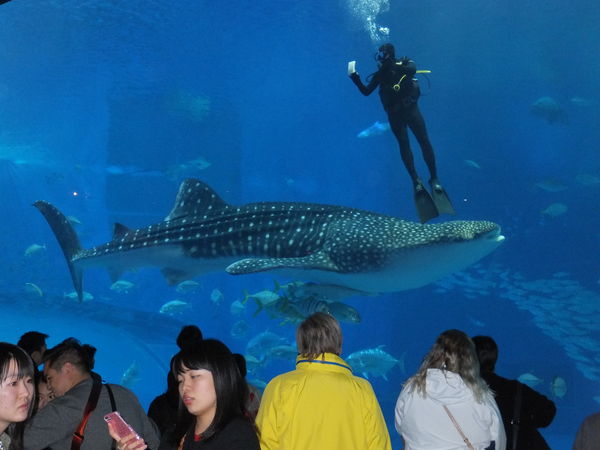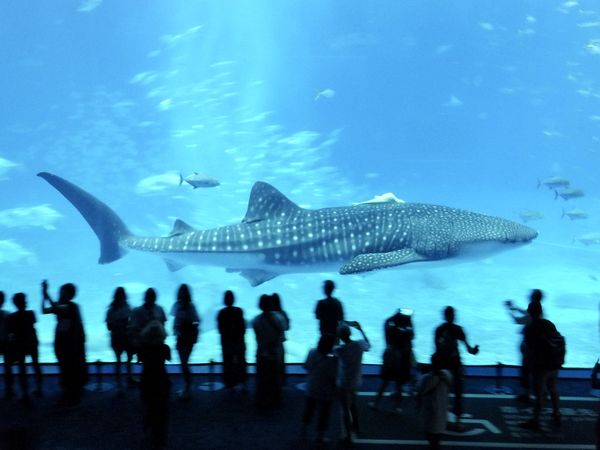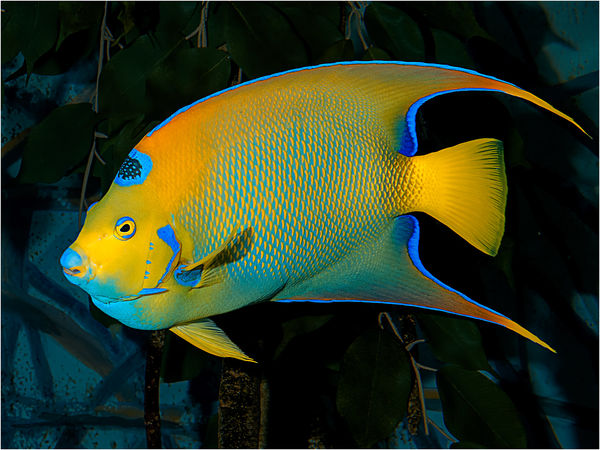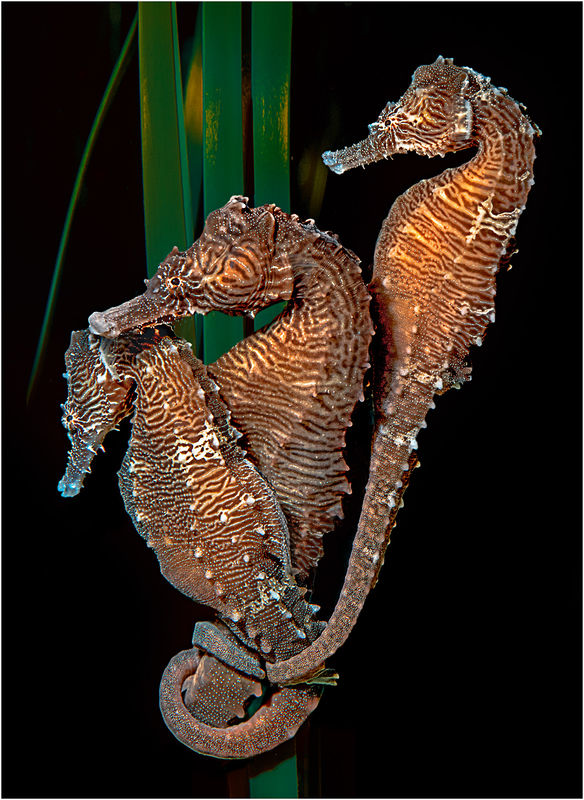Photography in an aquarium
Jan 4, 2020 13:02:27 #
bpulv
Loc: Buena Park, CA
Bike guy wrote:
I have never attempted photos in an aquarium. Been a long time since I visited one.
Going in a couple of weeks on a group tour to the Atlanta Aquarium.
I appreciate any suggestions on lenses and techniques. I will be using a Canon 80D, and I have a variety of lenses including some primes.
Going in a couple of weeks on a group tour to the Atlanta Aquarium.
I appreciate any suggestions on lenses and techniques. I will be using a Canon 80D, and I have a variety of lenses including some primes.
The biggest problem with aquarium photography or any time you are shooting through a window is glare and reflections from what is behind you. I have found that using a LenSkirt https://www.bhphotovideo.com/c/search?Ntt=lenskirt&N=0&InitialSearch=yes&sts=ma&Top+Nav-Search= is the best solution. You can use off camera flash in an aquarium by using the LenSkirt and holding the flash about arms length away from the lens. That way the reflected light will be reflected back to the flash rather than to the camera.
Jan 4, 2020 13:44:01 #
Use a circular polarizing filter, it is a must in aquariums. f5.6 should give enough DOF. 1.4, 1.8, 2.8 don't give you enough DOF and will cause focusing issues. Shutter speed at 250 or higher. High ISO, 6400 will allow you to get the fast shutter speed. Use auto WB as there is mixed lighting, trust the camera. As for a lens I am usually at 35mm - 50mm. I use a 24-105 lens because at times I want a little more reach. A rubber hood is helpful as it will keep some unwanted light from hitting the lens.
Jan 4, 2020 13:47:38 #
willaim wrote:
Don't use any flash. If you have a rubber lens hood, you can then bring your lens up to the glass to cut any reflections. If you use auto focus, set it to AI Servo. Also set the drive to continuous mode. You'll probably will need a higher ISO. Here's a couple of pictures I shot at the Tampa Aquarium using a Canon 80D. ISO was set at 6400 and used shutter priority.
Very Nice
Jan 4, 2020 14:35:10 #
I got a lot of good pics at the aquarium in ATL. Careful of reflections, take pics at slight angle if necessary. Best pics I took were of jellyfish, blue lights made a great photo, now on metal.
I used my Olympus 1.4, 17 as I remember.
I used my Olympus 1.4, 17 as I remember.
Jan 4, 2020 15:08:37 #
HatsuoHiga
Loc: Hawaii
Tinkwmobile wrote:
I got a lot of good pics at the aquarium in ATL. Careful of reflections, take pics at slight angle if necessary. Best pics I took were of jellyfish, blue lights made a great photo, now on metal.
I used my Olympus 1.4, 17 as I remember.
I used my Olympus 1.4, 17 as I remember.
The best I have seen is the Churaumi in Okinawa. The place was the set for the Ocean Expo in the early 80's, and the place is huge. There are several escalators to go from place to place, or trolley shuttles. There is a huge aquarium with 2 whale sharks (jimbei is the japanese name) there used to be 3 whale sharks when I first visited the place, and another aquarium with a good dolphin show. The place is always full with many tourists standing watching the show.


Jan 4, 2020 19:03:29 #
bpulv wrote:
The biggest problem with aquarium photography or a... (show quote)
LenSkirt is a nice item for situations like this. I like it. But with flash you can stop movement better and get better resolution and color as in these shots. Shot at ISO 200, f 22, TTL flash. However you must use the flash against the glass and you won't have to worry about reflections. You can ditch the polarizer then too. Be aware, some aquariums prohibit flash.
Jan 4, 2020 19:15:42 #
cahale
Loc: San Angelo, TX
Get one of the rubber round lens hoods, and take shots with it pressed lightly against the glass. This will eliminate almost all glare, and be nearly as good as (the camera) actually being in the water. Also, shoot with as fast a shutter as you can get away with. Bring up the exposure in post processing (pp to those lazy persons out there).
Jan 4, 2020 22:59:00 #
I used off camera flash at the Monterey Bay Aquarium(when you could use flash) and I held the flash flush against the glass or at a 45 degree angle. Great results!!
Jan 5, 2020 09:05:53 #
JeffR
Loc: Rehoboth Beach, Delaware
fetzler wrote:
I think that I would take my Nikon 16-80mm lens plus my macro lenses - Nikon 85 and Sigma 50mm for my D7200. If you have a different sensor size then adjust accordingly. I would defiantly include wide angle capability for large exhibits.
Other suggestions:
1. microfiber cloth for fingerprints on glass.
2. Lens skirt or get camera very close to the glass
3. You can use flash if the flash is NOT on the camera. Use a chord or RC remote and press the flash to the glass.
Other suggestions:
1. microfiber cloth for fingerprints on glass.
2. Lens skirt or get camera very close to the glass
3. You can use flash if the flash is NOT on the camera. Use a chord or RC remote and press the flash to the glass.
I've been to a lot of aquariums, but I've never been to one that allowed flash. I wouldn't use a flash even if it were allowed, as it would be extremely intrusive on the other visitors.
Jan 5, 2020 12:42:35 #
Jan 5, 2020 13:05:55 #
amfoto1
Loc: San Jose, Calif. USA
Mac wrote:
A flexible rubber screw-on lens hood so you can press the lens against the glass will help avoid light reflection.
It is usually dim in aquariums, so a fast prime will be helpful.
It is usually dim in aquariums, so a fast prime will be helpful.
Yes, this is a good idea.
If you use the rubber hood trick, it also makes it possible to use flash.... However, flash may not be allowed (check with the aquarium).
You also might find a quality circular polarizing filter helpful, controlling reflections off the glass (when you can't use the rubber hood/pressed against glass trick). I would recommend a "High Transmissive" (HT) C-Pol, such as the B+W F-Pro and XS-Pro series. HT C-Pol aren't as dark as typical polarizing filters. They block less light, which may be very useful if you need to use one in a dimly lit situation. A "standard" C-Pol blocks approx. 1.5 to 2.25 stops of light, depending upon the filter's setting. In comparison, the HT C-Pol block approx. 1 to 1.5 stops. That may not seem like a whole lot, but in low light situations it might be the difference between being able to "get the shot" or not.
Depending upon what lighting is used, you also might need to set a custom white balance. Be sure to know how to do that and to have a WB target available.
Shoot RAW (or RAW + JPEG). RAW files will need post-processing, but allow much more flexibility than JPEGs to adjust exposure, change white balance, control noise reduction and more.
Jan 5, 2020 14:51:00 #
Jan 6, 2020 17:40:30 #
JoSkalka
Loc: San Diego, CA
I would recommend the the 50mm 1.8 with a rubber hood; I think I bought mine from Amazon pretty inexpensively. Get there when they open so you can stay ahead of all the fingerprints on the glass and wear black or dark clothing to minimize your own reflection.
Jan 7, 2020 14:14:25 #
Bike guy wrote:
I have never attempted photos in an aquarium. Been a long time since I visited one.
Going in a couple of weeks on a group tour to the Atlanta Aquarium.
I appreciate any suggestions on lenses and techniques. I will be using a Canon 80D, and I have a variety of lenses including some primes.
Going in a couple of weeks on a group tour to the Atlanta Aquarium.
I appreciate any suggestions on lenses and techniques. I will be using a Canon 80D, and I have a variety of lenses including some primes.
I would get a rubber lens hood and put the hood touching the glass. Be careful about white balance.
If you want to reply, then register here. Registration is free and your account is created instantly, so you can post right away.





